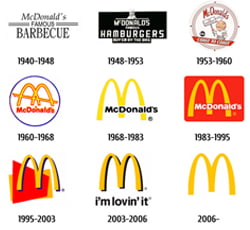
In today’s fast-paced environment, it truly is a case of ‘adapt or die’. To some, this may mean, adjusting working hours to appeal to an audience, increasing or scaling back your offering, embracing the world of social media, or in some cases, it means re-branding. In reality, re-branding is a common business move, a recent example of this is Uber’s brand overhaul. Unless they are serious changes, as consumers we typically don’t notice the subtle changes that businesses make to their brands, such as colour changes to a logo, straplines, or a change of font. A business rebrand, however small, can be of huge significance; upward growth, a shift in consumer perception, or a commitment to its evolution.
Re-branding has the potential to be a disruptive strategy, so is not a decision that should be taken lightly, and when it is the route that you want to take it should be initiated with care and precision. Each day across social media, there will be over 2 million negative brand mentions, and with this in mind – a re-brand is an activity that you simply can’t afford to get wrong.
But how do you know when it’s time to re-brand? This decision isn’t as difficult as you may think; re-branding is all about change, and when your business has naturally transformed to some extent, it’s time to take the plunge and let your overall brand reflect this. But how much of a change is enough for you to warrant submerging yourself in the heady world of rebranding?

You want to tap into a new audience
To enable your business to consistently progress, it can at times be necessary to target a new audience that has the potential to be interested in your offering.
For instance, while your business may conjure up a very specific image in one country you may want to explore foreign markets and may need an entirely different image in order to compete. A great example of this is an American beer – Pabst Blue Ribbon, known for being a cheap option, loved by ‘frat boys’. However, when they expanded to China, the brand decided to tap into the craft beer market and align the brand with this demographic. The Chinese version of the packaging is an elegant glass bottle, found in adverts pictured against champagne flutes. Same brand, same product, different branding.
Your market is evolving quickly
If the market that you are in is one that evolves quickly, rebranding a business might be necessary to ensure that you remain part of the competition. Your product or service might be cutting edge, but if your overall brand and its message don’t reflect this, then you could drop out of the race.
We look to the battle between Apple and Microsoft here – Apple’s offering is innovative and simple, but their super slick branding and at one time, they effortlessly made the Microsoft brand look tired and outdated in comparison – and who wants to spend money on ‘tired and outdated?
So, once you have recognised when it’s time to rebrand, the next crucial element is to understand how you undertake the process. Of course, this will be dictated by the type of rebrand, i.e., full or partial; a partial rebrand can be cultivated slowly with gradual changes. This strategy allows you to minimise the disruption to the business and test the elements, meaning that you can revert back or modify as necessary.

You want to leave behind an old image
Do you know who or what your brand is associated with?
In the late nineties and early noughties, anyone who graced the Jeremy Kyle stage was sporting an item of clothing with the famous Burberry check pattern. It quickly became a status symbol for the ‘chav culture’, and the trouble that they were associated led to the pattern being banned from pubs and clubs across the UK.
As you can imagine, this image was a huge problem for the brand, and launched an aggressive strategy to counteract the negative perception. Young and cutting-edge British celebrities like Emma Watson featured in advertising campaigns that exploited their ‘Britishness’ – intrinsically linked to the brand’s heritage.
They also cut back the house-check pattern to 10% of products.
So how do you begin this process? As mentioned earlier in this article, a re-brand is not to be taken lightly; a brand is more than its name, logo or marketing campaigns, it’s about a company’s identity.
Research
To understand your identity, you must consider your audience and ask them how they perceive the company, how do they feel about it and what do they expect? In short – a business doesn’t own its brand – the audience does.
The first step to rebranding is key, obtaining customer and prospect feedback allows you to shape your brand values and promises, which is the next step.
Employee Integration
Pull together your customer-facing employees and ask them what they would like the brand perception to be? Which qualities and feelings do they want to be associated with the brand, and how can the business make this happen, in their opinion – what needs to be done?
You need to decide what your business stands for, and how this is going to be a consistent message across every part of the brand. Signage, uniforms, social media, business cards, telephone manners, emails – every part of the business that your audience comes into contact with needs to deliver the same message; employee engagement is critical for this element.
Cut Dead Weight
As important as it is to figure out what is going to work, you need to identify the areas that aren’t working. What is preventing your audience from engaging with you? Whatever it is, change it or lose it.
Tell Your Story
Authentic storytelling should be an integral part of your brand, it distinguishes you from the competition and allows your audience to form an emotional connection with the brand; these emotions lead to loyal and trusting brand advocates. Your compelling brand story could stem from its (humble) beginnings, up to the present day and should effortlessly convey your values; this evergreen content can be shared in it different ways for years to come.
Stick with it
When you rebrand, you need to stick to be persistent with the changes – there is little point in reverting back to old habits that don’t reflect the new brand and its values. Fully commit to the re-brand, establish it and make tweaks where necessary. It takes a consumer 12 separate ‘touches’ with your brand to notice it, and just when you think everyone will have seen the new brand, they won’t – so persist further.
A rebrand might be a perfect way to breathe new life into your brand; just ensure that you fully understand your reasons for doing so in order to choose the right strategy, appealing to your chosen audience, and maintain a competitive edge.



